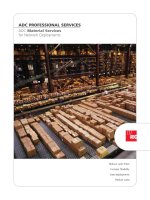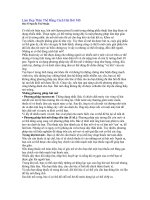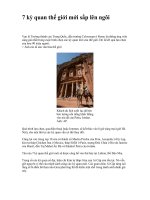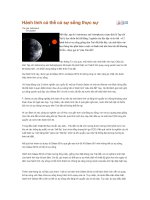Tài liệu BICSI News - Determine the right media for your networks doc
Bạn đang xem bản rút gọn của tài liệu. Xem và tải ngay bản đầy đủ của tài liệu tại đây (186.85 KB, 4 trang )
BICSInews
advancing information transport systems
March/April 2007
PRESIDENT’S MESSAGE 3
EXECUTIVE DIRECTOR MESSAGE 4
BICSI UPDATE 40-41
COURSE SCHEDULE 42-43
STANDARDS REPORT 44-46
Volume 28, Number 2
Determining the Right Media SS 20
Cabling for the Wireless Triple Play: Voice, Data and Video SS 24
Network Health Testing SS 31
Bend Radius Under Tensile Load SS 34
Weathering the Odds SS 16 Winning and Keeping Customers SS 38
Feature
The problem with having choices is that in the
end, you must make one. This is clearly apparent
with structured cabling where the primary protocol,
Ethernet, is supported by a variety of media types,
including singlemode and multimode fiber, different
categories of shielded and unshielded twisted pair copper,
and wireless. Regardless of what you may hear in the
marketplace, each media has an inherent set of strengths
and weaknesses. The choice you make as a network
designer should to be made based upon what is right for
the unique requirements of the network.
This article explores the advantages and disadvantages
of the common media types that are used today to
transmit Ethernet with a focus in on higher speeds such as
gigabit Ethernet and 10 gigabit Ethernet because these are,
for the most part, new to many network designs.
Optical Fiber Systems
Optical fiber is a valid media for transmitting gigabit
and 10 gigabit signals per IEEE 802.3z and 802.3ae,
respectively. The primary advantage of using optical fiber
is the capability of laser optimized optical fiber to increase
distances that 10 gigabit signals can run before being
regenerated. The IEEE 802.3ae standard defines distance
limitations of grades of fiber per the chart below.
The distance advantage makes optical fiber the best
choice for the areas in the network that require longer
distances such as:
» Campus backbone cabling
» Building backbone cabling
» Horizontal or centralized cabling for distances greater
than 100 meters, such as a factory environment or
large data center
The disadvantage of optical fiber is the cost of active
electronics such as switch ports and network interface
cards (NIC). It is estimated that the cost of 10GBASE-T
copper electronics will be roughly half the cost of 10
gigabit optical fiber equivalents initially and will continue
to drop as volume and technology progress.
Optical Fiber Advantages
» Distance
» Size of media, relative to copper solutions
» Security – impervious to EMI, extremely difficult to
tap or monitor without detection
» Bandwidth – future protocols beyond 10 gigabit will
be supported by fiber
Optical Fiber Disadvantages
» Electronics cost
» Inability to carry substantial power on the cable
» Installation – optical fiber today is more difficult to
field terminate than UTP copper
Determining the Right Media
Twisted pair, optical fiber or wireless—first examine the pros
and cons of each. BY JOHN SCHMIDT
IEEE Designation Bandwidth Distance Common Solutions
Standard Limitation Applications
802.3z 1000Base-SX 1000 Mb/s 220 to 550 meters Enterprise backbone » Laser Optimized
Multimode Fiber
802.3z 1000Base-LX 1000 Mb/s 5 kilometers WAN, MAN » Singlemode Fiber
802.3ae 10GBase-SR/SW 10 Gb/s 300 meters Data Center and Enterprise » Laser Optimized
Backbone Cabling Multimode Fiber
802.3ae 10GBase-LR/LW 10 Gb/s 10 kilometers WAN, MAN » Singlemode Fiber
802.3ae 10GBase-ER/EW 10 Gb/s 40 kilometers WAN » Singlemode Fiber
802.3ae 10GBase-LX-4 10 Gb/s 300 meters Data Center and Enterprise » Standard Grade
Backbone Cabling Multimode Fiber
802.3ae 10GBase-LX-4 10 Gb/s 10 kilometers WAN, MAN » Singlemode Fiber
Reprinted with permission from March/April 2007 BICSI News
» Compatibility – requires singlemode or multimode
specific electronics
Work is underway to enable power over fiber (PoF)
and it appears at this writing that enough power to
operate a transceiver is possible. However, it also appears
questionable today if PoF can deliver enough power for
devices such as IP phones.
Shielded Twisted Pair Systems
There are different types of shielded systems:
» S/FTP – shielded overall cable with individual foiled
twisted pairs, also known as ISO Class F or category 7.
» F/UTP – foil over unshielded twisted pairs, also
known as foiled twisted pair (FTP) or screened
twisted pair (ScTP). This design does not meet ISO
Class F or category 7 requirements and can be used
to meet augmented category 6 requirements.
Shielded twisted pair systems are popular in Germany,
France, Switzerland and parts of eastern Europe. Shielded
systems are not pervasive in the U.S. or other regions
of the world, especially in the U.S. where unshielded
twisted pair (UTP) has been the dominant choice for
copper media. According to the Building Services Research
International Association (BSRIA), over six billion feet of
UTP cable was installed in the U.S. in 2006, compared to
90 million feet of F/UTP and three million feet of S/FTP. In
2006, shielded systems accounted for about 1.6 percent of
all installations in the U.S.
A properly installed and grounded shielded system
effectively suppresses alien crosstalk, which is noise
between cables in a bundle, for 10GBASE-T applications.
However, as with any copper system, an improperly
grounded shielded system will perform poorly because
the shields may become antennas when there is no
ground for radiating signals to flow to. It is critical to
use a certified and properly trained contractor that is
experienced with shielded systems when doing this type
of installation.
When considering a shielded system it is also critical
to consider all of the electrical parameters, and not just
alien crosstalk. For a given conductor size, UTP cables will
have superior attenuation characteristics as compared to
S/FTP and F/UTP systems because shields absorb some of
the radiated energy from the signaling conductors. Also, if
patch cords used in a shielded system are 26 AWG, versus
24 AWG in UTP systems, this smaller gauge of copper can
further compromise the attenuation of the system.
STP Advantages
» Distance – supports 10GBASE-T for 100 meters
» Internal noise suppression (S/FTP)
» External noise suppression (S/FTP and F/UTP)
» Backwards compatibility – supports
10/100/1000BASE-T
STP Disadvantages
» Market share within North America
» Installation, relative to UTP
» Attenuation, relative to UTP where smaller
conductors are used
» Size and cost of media, relative to UTP
Of course, installation practices can vary. Yet today,
termination time for STP systems can be two to three
times longer than for UTP systems. More problematic
is finding a contractor in North America trained and
experienced with installing and grounding STP.
Category 6 UTP
Category 6 supports gigabit Ethernet and is
recognized by standards bodies as supporting 10GBASE-T,
however there are limitations that must be considered.
The IEEE 802.3an standard cites a 55 meter distance
limitation for standard category 6, which is not
universally agreed upon within the TIA and ISO standards.
TIA TSB 155 recently released a Technical Service Bulletin
covering additional parameters for running 10GBASE-T on
standard category 6. In this document a 37 meter distance
limitation is referenced for 10GBASE-T on standards-
compliant category 6 systems. Between 37 meters and
the IEEE referenced 55 meters, standard category 6 may
support 10GBASE-T, but it is possible that the installer
may have to use alien crosstalk mitigation techniques
such as unbundling cables or replacing patch cords to
improve the electrical parameters to allow 10GBASE-T
to work properly. Above 55 meters, it is unlikely that
category 6 UTP would work properly without a large
amount of mitigation to reduce alien crosstalk.
A key takeaway is that using category 6 UTP for
10GBASE-T should be focused on existing installations,
not new installations. The choice for new installations
designed to support 10GBASE-T should be augmented
category 6 UTP, STP or optical fiber systems.
Category 6 Advantages
» Cost and size of media, relative to augmented
category 6 and STP
» Installed base – currently the dominant UTP cabling
standard
» Installation – widely accepted
Category 6 Disadvantages
» Limited distance for 10GBASE-T
» External noise suppression at 100 m, relative to
shielded systems or augmented category 6
There is no standard released or in draft state for
“category 6E,” and there is no alien crosstalk performance
advantage with category 6E. Category 6E was a marketing
effort to show additional headroom on the internal
Reprinted with permission from March/April 2007 BICSI News
Feature
electrical parameters for category 6 UTP. From an
application standpoint, the IEEE does not recognize
category 6E as having any advantage over category 6
for 10GBASE-T, so the same 37 and 55 meter distance
limits would apply to so-called category 6E systems. It
is important not to confuse category 6E or “enhanced”
category 6 with augmented category 6 or category 6A,
which are standards based. Category 6E or enhanced
category 6 has no standard associated with it.
Augmented Category 6 UTP
The newest media for the transmission of 10 gigabit
Ethernet is augmented category 6 UTP, also referred to
as category 6A. Augmented category 6 was specifically
designed to support the IEEE 802.3an 10GBASE-T
standard. It differs from standard category 6 in that it is
tested to 500 MHz (versus 250 MHz) and has additional
parameters for mitigation of alien crosstalk. Improvement
of these electrical parameters is what allows augmented
category 6 to run 10GBASE-T for a full 100 meters.
The primary concern with augmented category
6 UTP is the size of the cable, which could be as large
as 0.354 inches in diameter. Most vendors offering an
augmented category 6 solution have sized cable in the
0.310 inch diameter range while, currently, the smallest
augmented category 6 cable measures 0.275 inches in
diameter. Cable with smaller outside diameter helps
alleviate issues and concerns surrounding diminished
conduit and tray fill rates.
Augmented Category 6 Advantages
» Distance, relative to category 6 – supports 10GBASE-
T for 100 meters
» Installation – comparable to category 6, for smaller
diameter cable
» External and internal noise suppression, relative to
category 6
» Enhanced performance for PoE Plus – larger
conductor and cable size
Augmented Category 6 Disadvantages
» Size of media, relative to category 6 or optical fiber
» External noise suppression, relative to S/FTP and
F/UTP
» Standardization – TIA and ISO standards are still in
draft state, although draft standards are available
PoE Plus is proposed to push over 30 Watts of power
down two pairs of cable. Heat dissipation is a concern
per IEEE studies. Yet it is known from IEEE testing that
a larger conductor has less resistance and less heat
generation due to resistance. The larger augmented
category 6 cables are also able to dissipate heat better
because the conductors are spaced apart from each other
to suppress alien crosstalk.
Wireless (IEEE 802.11x)
Wireless technology continues to progress and
be a convenient way to give users more freedom and
accessibility to the network. Largely, these wireless
networks are an overlay to the existing wired network.
Although security was once a concern on these networks,
encryption and authentication has progressed to a
point where casual intrusion is really not an issue. The
advantages of a wireless network are obvious as users are
free to move about without restriction, making wireless
an attractive solution for common areas and conference
rooms. The primary concern with wireless becomes an
issue of both capacity and coverage. Too many users on
a given access point will limit the available bandwidth
to each user, which even at maximum capacity is limited
to 54 Mb/s (IEEE 802.11g). Additionally, the larger the
coverage area, the more access points that are required,
which can cause co-channel interference that further
limits bandwidth. Future standards may address this by
increasing the amount of bandwidth available.
Wireless Advantages
» Mobility
» Ease of deployment
» Standardization
Wireless Disadvantages
» Coverage–limited to type and number of access points
» Capacity
Conclusion
There are distinct advantages and disadvantages
for each media type. It is critical that each of these is
factored into network design. In many cases several of the
above media will be deployed into a single network—for
example, deployment of category 6 to each desktop
with a wireless overlay or augmented category 6 in the
data center with and a fiber infrastructure to support
the building and data center backbone and storage
area network. Each network has specific needs and
requirements, so it is important to make your decisions
based on the strengths and weaknesses of available media
for the project. n
John Schmidt
John Schmidt is senior product manager,
structured cabling, for ADC in Minneapolis, MN.
For more information, visit www.adc.com/truenet
or contact John at
Reprinted with permission from March/April 2007 BICSI News









